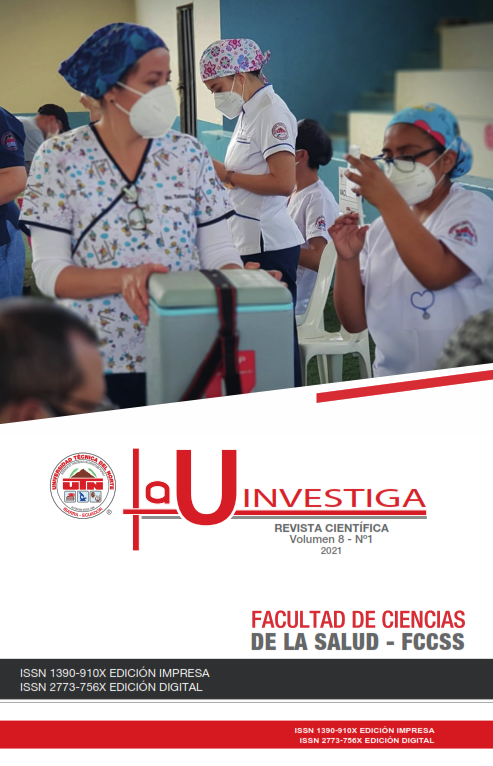Sociodemographic components that affect exclusive breastfeeding
Sociodemographic components that affect exclusive breastfeeding
DOI:
https://doi.org/10.53358/lauinvestiga.v8i1.440Keywords:
componente, socio demografía, Lactancia materna exclusiva, conocimiento, prácticas, creencias.Abstract
Introduction: Exclusive breastfeeding is necessary for the feeding, nutrition and wellbeing of the child. For decades worldwide there has been the premature abandonment of this elementary practice that directly affects the growth and integral development of the child. Objective: To identify the socio-demographic components that affect exclusive breastfeeding. Materials and methods: The study has a descriptive, crosssectional design, a structured and validated survey was applied to 419 mothers using stratified probability sampling of a total population of 3000 lactating mothers from Zone 1 of Ecuador calculated with 95% confidence and 5% error; the variables are sociodemographic characteristics, which included age, ethnicity, occupation, related to the time of exclusive breastfeeding. Results: The mestizo ethnic group predominates
with 43.4%; In general, 41.5% fed EBF up to six months, with indigenous women standing out with 47.1% as the ethnic group that maintains this practice. Regarding age, mothers over 35 years of age, which corresponds to 53.2%, exceed adolescents and young women in compliance with WHO recommendations, while 42.2% of non-working mothers provide breastfeeding. Conclusions and Recommendations: Exclusive breastfeeding has been affected mainly by maternal age, the younger the mother, the more likely abandonment is, according to ethnicity, indigenous women give more breastfeeding followed by Afro-descendants and mestizos. The implementation of relactation could be a strategy for the integral development of the child.
Downloads
References
Rodicio MM AASMRMAAVM. Tendencia y evolución de la lactancia materna en el norte de Lugo. Acta Pediátrica. 2007; 65(6-11).
Martin RM GDSG. Breastfeeding in Infancy and Blood Pressure in Later Life. Systematic Review and Meta-Analysis. 2005; 161(15-26).
WHO/UNICEF. World Health Organization. Infant and Young Child Nutrition. Global strategy for Infant and Young Child Feeding [Internet]. [Online].; 2013 [cited 2018 09 15. Available from: http://apps.who.int/gb/archive/pdf_files/WHA55/ea5515.pdf.
Cruz L. Estimulación en edades tempranas: Instituto Pedagogico Latinoamericano y Caribeño; 2005.
Naranjo R. Diseño de un manual educativo en lactancia materna dirigido a las madres de los niños que asisten a la guardería estrellitas del mañana. licto.2010-2011. Riobamba:; 2011.
ENSANUT-ECU 2012. Encuesta nacional de salud y nutrición. Quito: INEC, MSP- Ecuador; 2012.
Campoverde Z, Maria C. Estrategia Educativa en Lactancia Materna para adolescentes embarazadas que asisten al centro de salud Pumango. Cuenca:; 2014.
UNICEF. Informe Anual de UNICEF. New York:; 2011.
Ecuador MdSPd. Iniciativa mundial sobre tendencias de lactancia materna. Informe nacional. Quito: Ministerio de Salud Pública, Coordinación Nacional de Nutriciñon; 2012.
Tiempo de lactancia materna exclusiva y estructura familiar. Revista Cubana de Pediatría. 2016 marzo; 88(1).
Guíasalud.es. Manejo de los problemas con la lactancia materna. [Online].; 2019 [cited 2019 12 15. Available from: https://portal.guiasalud.es/egpc/lactancia-manejo/.
Familia Se. Infancia y familia. [Online].; 2010 [cited 2019 12 15. Available from: http://www.saludenfamilia.es/general.asp?seccion=137.
Pediatría Aed. Recomendaciones sobre lactancia materna del Comité de Lactancia Materna de la Asociación Española de Pediatría. [Online].; 2012 [cited 2019 12 15. Available from: https://www.aeped.es/comite-nutricion-y-lactancia-materna/lactancia-materna/documentos/recomendaciones-sobre-lactancia-materna.
Organización Mundial de la Salud. http://www.who.int. [Online].; 2015 [cited 2015 11 12. Available from: http://www.who.int/nutrition/topics/complementary_feeding/es/.
Guia de Lactancia Materna. https://guiadelactanciamaterna.wordpress.com. [Online].; 2011 [cited 2015 11 12. Available from: https://guiadelactanciamaterna.wordpress.com/preguntas-frecuentes/.
Lucas Carrillo EA. http://www.monografias.com/. [Online].; 2015 [cited 2015 11 12. Available from: http://www.monografias.com/trabajos11/lama/lama.shtml#ixzz3rL65n781.
Published
How to Cite
Issue
Section
License
Copyright (c) 2021 Darwin Jaramillo, José Hidrobo, Tatiana Vásquez, Yu Ling Reascos Paredes

This work is licensed under a Creative Commons Attribution-NonCommercial 4.0 International License.
The authors retain the copyright and guarantee the journal the right to be the first publication of the work as well as licensed under a Creative Commons Attribution-NonCommercial-ShareAlike 4.0 International License that allows others to share the work with an acknowledgment of the authorship of the work and the initial publication in this magazine. Authors may separately establish additional agreements for the non-exclusive distribution of the version of the work published in the journal (for example, placing it in an institutional repository or publishing it in a book), with an acknowledgment of its initial publication in this journal.

La U Investiga by La U Investiga is licensed under a Creative Commons Reconocimiento-NoComercial-CompartirIgual 4.0 Internacional License.You can find permissions beyond those granted with this license athttp://revistasojs.utn.edu.ec/index.php/lauinvestiga/index





